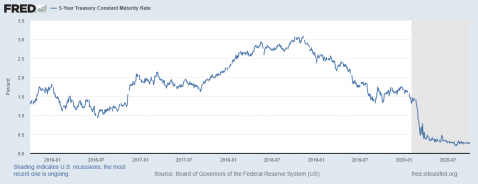
Yields on 5-year U.S. Treasury Notes continue to remain at lows reached as we began the era of COVID. As can be seen in the chart above, these rates, most closely tracked for commercial real estate financing cost, plummeted from what were already considered low levels to under 50 basis points (0.5%), barely hovering over zilch, where they have been since. Though borrowing costs have not followed this point for point, they’re nonetheless lower.
This low interest rate environment is powerful for real estate as an asset class. There are of course ongoing concerns about vacancy rates and rent growth in a slower economy, but lower interest rates mean a lower cost of capital. Plus, real estate income becomes relatively more attractive to fixed income investments. Vacancy and rent growth effects remain unknown, but lower interest rates are known – now.
The interest rate environment has the ability to affect commercial property economics in a number of different ways (see this and this). Borrowing costs are, of course, affected directly, as higher interest rates increase the cost of borrowing and thus negatively affecting demand. Cap rates tend move over time with interest rates, but not in lockstep, with considered analyses generally concluding that capitalization rates on average move in the same direction as 10-year rates, but only about a third as much, and again not in lockstep. Interest rates also affect the economy, which in turn affects vacancy and rental rates.
